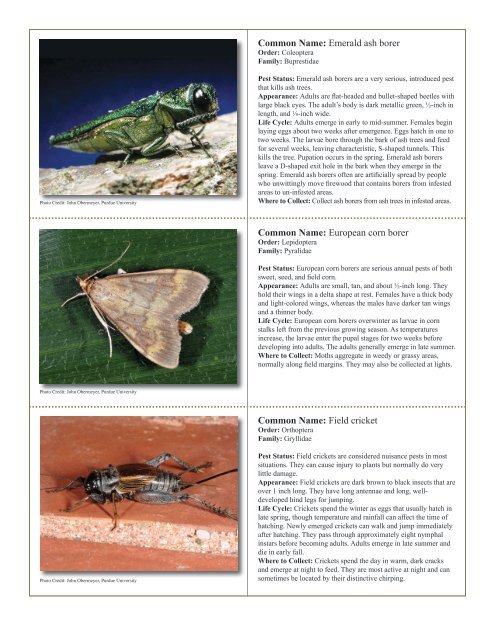to download pdf - Purdue Extension Entomology - Purdue University
to download pdf - Purdue Extension Entomology - Purdue University
to download pdf - Purdue Extension Entomology - Purdue University
Create successful ePaper yourself
Turn your PDF publications into a flip-book with our unique Google optimized e-Paper software.
Common Name: Emerald ash borer<br />
Order: Coleoptera<br />
Family: Buprestidae<br />
Pho<strong>to</strong> Credit: John Obermeyer, <strong>Purdue</strong> <strong>University</strong><br />
Pest Status: Emerald ash borers are a very serious, introduced pest<br />
that kills ash trees.<br />
Appearance: Adults are flat-headed and bullet-shaped beetles with<br />
large black eyes. The adult’s body is dark metallic green, ½-inch in<br />
length, and 1 ⁄8-inch wide.<br />
Life Cycle: Adults emerge in early <strong>to</strong> mid-summer. Females begin<br />
laying eggs about two weeks after emergence. Eggs hatch in one <strong>to</strong><br />
two weeks. The larvae bore through the bark of ash trees and feed<br />
for several weeks, leaving characteristic, S-shaped tunnels. This<br />
kills the tree. Pupation occurs in the spring. Emerald ash borers<br />
leave a D-shaped exit hole in the bark when they emerge in the<br />
spring. Emerald ash borers often are artificially spread by people<br />
who unwittingly move firewood that contains borers from infested<br />
areas <strong>to</strong> un-infested areas.<br />
Where <strong>to</strong> Collect: Collect ash borers from ash trees in infested areas.<br />
Common Name: European corn borer<br />
Order: Lepidoptera<br />
Family: Pyralidae<br />
Pest Status: European corn borers are serious annual pests of both<br />
sweet, seed, and field corn.<br />
Appearance: Adults are small, tan, and about ½-inch long. They<br />
hold their wings in a delta shape at rest. Females have a thick body<br />
and light-colored wings, whereas the males have darker tan wings<br />
and a thinner body.<br />
Life Cycle: European corn borers overwinter as larvae in corn<br />
stalks left from the previous growing season. As temperatures<br />
increase, the larvae enter the pupal stages for two weeks before<br />
developing in<strong>to</strong> adults. The adults generally emerge in late summer.<br />
Where <strong>to</strong> Collect: Moths aggregate in weedy or grassy areas,<br />
normally along field margins. They may also be collected at lights.<br />
Pho<strong>to</strong> Credit: John Obermeyer, <strong>Purdue</strong> <strong>University</strong><br />
Common Name: Field cricket<br />
Order: Orthoptera<br />
Family: Gryllidae<br />
Pho<strong>to</strong> Credit: John Obermeyer, <strong>Purdue</strong> <strong>University</strong><br />
Pest Status: Field crickets are considered nuisance pests in most<br />
situations. They can cause injury <strong>to</strong> plants but normally do very<br />
little damage.<br />
Appearance: Field crickets are dark brown <strong>to</strong> black insects that are<br />
over 1 inch long. They have long antennae and long, welldeveloped<br />
hind legs for jumping.<br />
Life Cycle: Crickets spend the winter as eggs that usually hatch in<br />
late spring, though temperature and rainfall can affect the time of<br />
hatching. Newly emerged crickets can walk and jump immediately<br />
after hatching. They pass through approximately eight nymphal<br />
instars before becoming adults. Adults emerge in late summer and<br />
die in early fall.<br />
Where <strong>to</strong> Collect: Crickets spend the day in warm, dark cracks<br />
and emerge at night <strong>to</strong> feed. They are most active at night and can<br />
sometimes be located by their distinctive chirping.
















